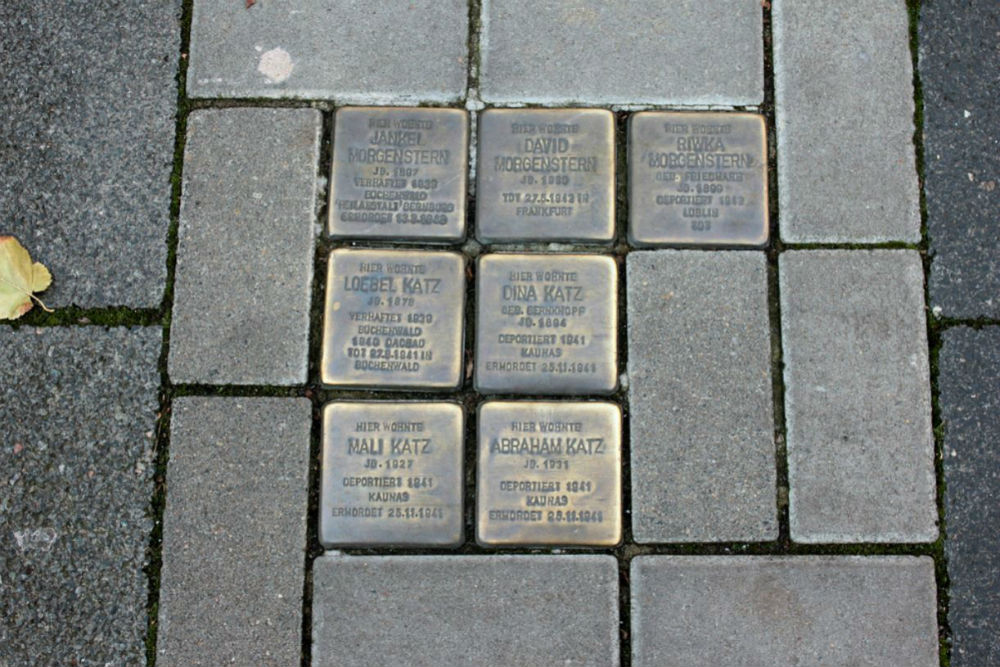Stumbling Stones Fischerfeldstraße 16
These small, brass memorial plaques (Stolpersteine or stumbling stones) commemorate members of the Morgenstern and Katz families:
* Jankel Morgenstern, born 1897, arrested 1939 Buchenwald, Bernburg ‘Sanatorium’, murdered 13 March 1942.
* David Morgenstern, born 1930, dead 27 May 1942, Frankfurt.
* Riwka Morgenstern née Friedmann, born 1899, deported 1942, Lublin, dead.
* Loebel Katz, born 1878, arrested 1939, Buchenwald, 1940 Dachau, dead 27 August 1941 in Buchenwald.
* Dina Katz née Bernknopf, born 1894, deported 1941, Kaunas, murdered 25 November 1941.
* Mali Katz, born 1927, deported 1941, Kaunas, murdered 25 November 1941.
* Abraham Katz, born 1931, deported 1941, Kaunas, murdered 25 November 1941.
Jankel Morgenstern, born in Poland, moved to Frankfurt as a child in the early 1900s. He became a merchant and married Rowka Friedmann in 1925. They had two sons – Felix born in 1926, and David born in 1930. Riwka operated a clothing shop from 1928-1930. The family of four were deported to the Polish border on 28 October 1938. They were now considered stateless, and Poland refused them entry. They returned to Frankfurt and lived at this location. The next July, Felix was sent on a Kindertransport to Britain. In September, Jankel was taken in "protective custody" and was put into Buchenwald. On 13 March 1942, he was sent to a mental institution, Bernburg, and murdered in the gas chamber there the same day. How Riwka and David died is uncertain. One source claims David, age 12, committed suicide 27 May 1942 in Frankfurt, two weeks after his father’s death; another claims that is unlikely. It is possible that Riwka was alive that May because both father and son were buried in the same cemetery. If she was alive, her deportation to Lublin likely occurred in June, and she might have have been murdered in Sobibor. Felix joined a Scottish regiment, changed his name to George Melvin, fought for Britain in the war, then emigrated to the US. His son, David Melvin from the US, attended the 2008 ceremony to lay these Morgenstern stolpersteine.
Loebel (Löbl) Katz was a Polish citizen, born in the town of Auschwitz. He moved to Frankfurt in 1910. He married Dina Bernknopf (also called Dina Goldfinger) in 1928. This was probably his second marriage. He was a merchant who worked in a variety of occupations including trading in soap, trading in chocolate, picture framing, and art. Then he was arrested several times. The first arrest in Octoer 1938 resulted in his deportation back to Poland as part of the "PolenAktion." He returned to Frankfurt. In June of 1939, he filed a petition to ship his goods to Britain; it was approved, but he did not emigrate. His arrests in September and October 1939 led to his imprisonment in Buchenwald. In October 1940 he was sent to Dachau. Then the next year was returned to Buchenwald, where he was killed a month later. His wife Dina Katz and two sons Abraham and Mali were deported together from Frankfurt in October 1941 and were killed three days later in Fort IX, Kaunas (Lithuania), along with 2,931 other Jews that day. Fort IX was the site where approximately 40,000 Jews were executed at shooting pits.
"Stolpersteine" is an art project for Europe by Gunter Demnig to commemorate victims of National Socialism (Nazism). Stolpersteine (stumbling stones) are small, 10x10cm brass plaques placed in the pavement in front of the last voluntary residence of (mostly Jewish) victims who were murdered by the Nazis. Each plaque is engraved with the victim’s name, date of birth, and place (mostly a concentration camp) and date of death. By doing this, Gunter Demnig gives an individual memorial to each victim. One stone, one name, one person. He cites the Talmud: "A human being is forgotten only when his or her name is forgotten."
For more information and pictures, please visit Stolpersteine Frankfurt am Main (in German). Go to: Stolpersteine in der Innenstadt, Fischerfeldstraße 16.
Do you have more information about this location? Inform us!
Source
- Text: Fedor de Vries & Anne Palmer
- Photos: Sascha Stefan Ruehlow
- Frankfurt am Main: Stolpersteine
- Yad Vashem Central Database of Shoah Victims’ Names
- Holocaust Research Project: Forts VII and IX
- Stolpersteine.eu
Nearby
Point of interest
- Air-Raid Shelter Friedberger Anlage - Frankfurt am Main
- House Anne Frank - Frankfurt am Main
- Frank Family House - Frankfurt am Main
Monument
- Jewish Memorial Frankfurt am Main - Frankfurt am Main
- Memorial Börneplatz Synagogue - Frankfurt am Main
- Memorial Bombardments Frankfurt - Frankfurt am Main
Cemetery
- German War Graves Hauptfriedhof Frankfurt - Frankfurt am Main
- Mass Grave Concentration Camp Victims Frankfurt - Frankfurt am Main
- Soviet & Serbian War Graves Hauptfriedhof Frankfurt - Frankfurt am Main





